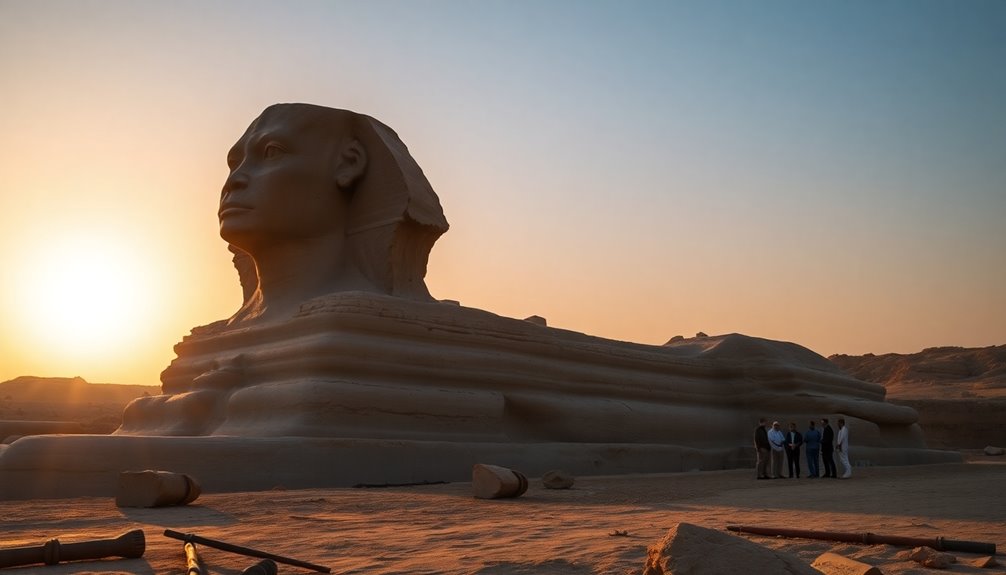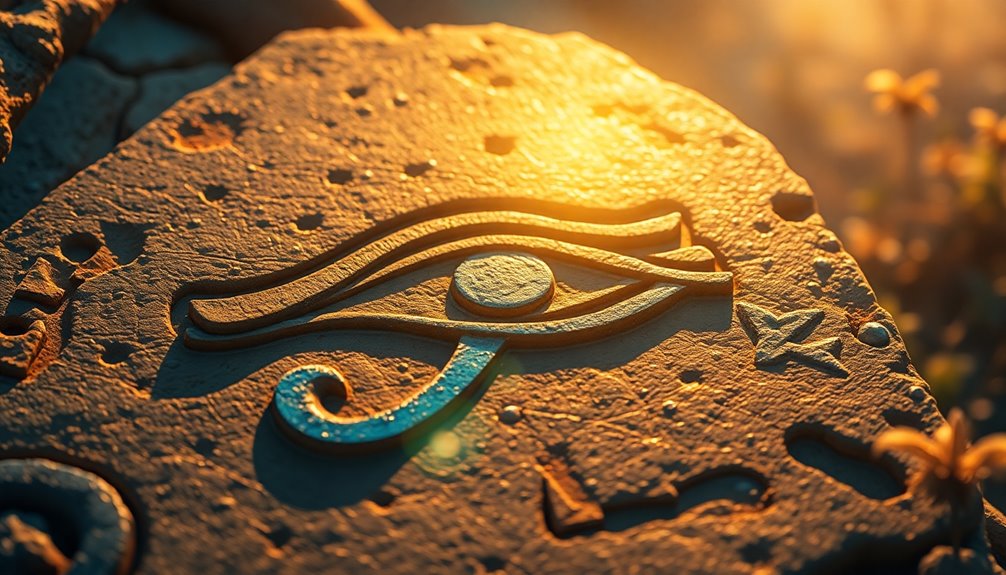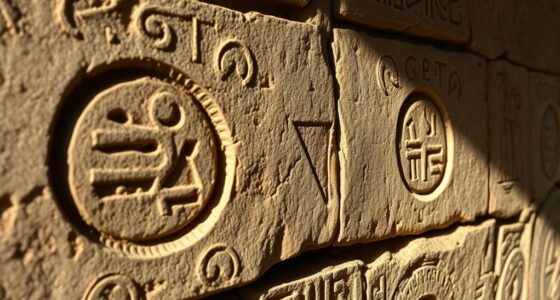The claim that the Sphinx is 26,000 years old is based on emerging evidence like erosion patterns and historical documents. While it was traditionally believed to have been built around 2500 B.C. under Pharaoh Khafre, new research suggests it could date back to 5000 B.C. or earlier. Geological studies show signs of significant water damage, indicating a wetter climate in the past, which might support this theory. This challenges the established timeline of the Sphinx and its construction. There's much more to uncover about this ancient monument's origins and significance, and you'll find some fascinating insights ahead.
Key Takeaways
- Geological evidence suggests the Sphinx may date back to between 10,000 and 5,000 B.C., challenging the traditional view of its age.
- Erosion patterns indicate significant water exposure, pointing to a wetter climate that could support earlier dating for the Sphinx.
- Theories propose advanced construction techniques and possible connections to a lost civilization from the last ice age.
- The Inventory Stela implies the Sphinx predates Khafre, raising questions about its ownership and construction attribution.
- Ongoing debates and research continue to explore the Sphinx's age and origins, with no definitive conclusions yet reached.
Historical Context of the Sphinx
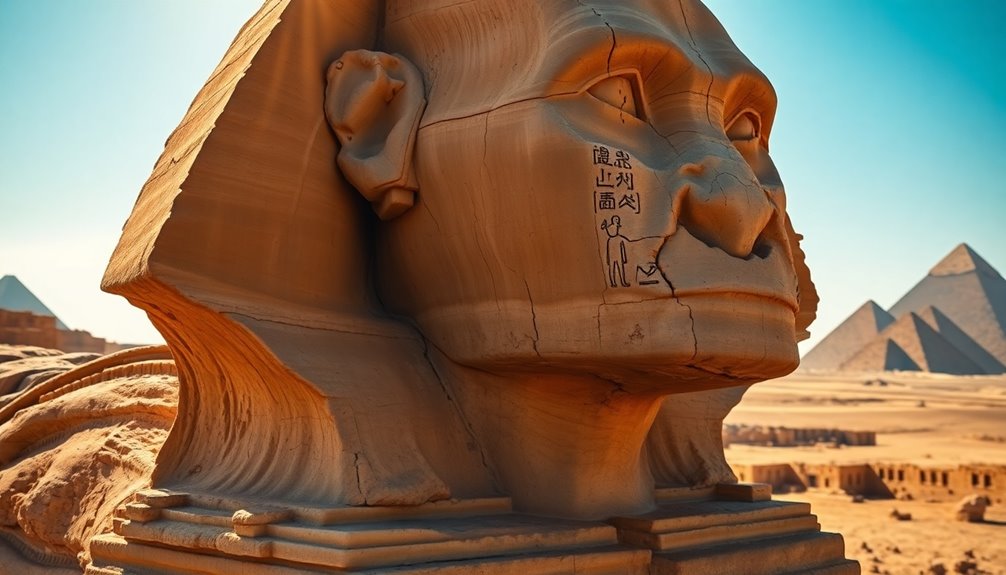
The Great Sphinx, often shrouded in mystery, stands as a tribute to the grandeur of ancient Egypt. Traditionally, it's believed that the Sphinx was constructed around 2500 B.C. during the Fourth Dynasty, specifically under Pharaoh Khafre's reign.
However, emerging evidence suggests that its origins might stretch back to as early as 5000 B.C., challenging long-held beliefs about the age of the Sphinx.
This iconic monument is part of the Giza necropolis, an area rich with the pyramids of Khufu and Khafre, located roughly six miles west of Cairo. The Sphinx symbolizes kingship and acts as a guardian of the cemetery, reflecting how ancient Egyptians viewed their connection to the divine and the afterlife.
Interestingly, historical documents like the Inventory Stela hint that the Sphinx may have existed prior to Khafre's rule, raising questions about its true origins.
The Fourth Dynasty was a time of remarkable prosperity and monumental construction, marking the peak of pyramid building in ancient Egypt.
Understanding the historical context of the Great Sphinx of Giza offers a glimpse into the complexities of this ancient civilization's achievements and beliefs.
Geological Evidence and Erosion
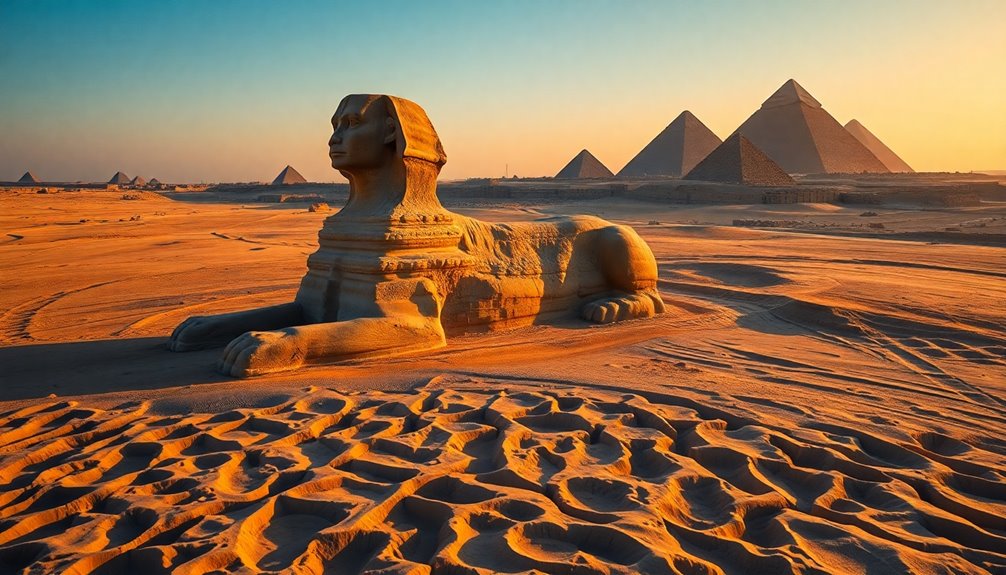
When you examine the Sphinx, the erosion patterns reveal a fascinating geological story.
Evidence of water erosion suggests that this area experienced significant rainfall long before the traditional dating of the monument.
This challenges what you might think about the Sphinx's age and its construction timeline.
Water Erosion Patterns
Erosion patterns on the Sphinx reveal a fascinating history that challenges our understanding of its timeline. The distinct water erosion features suggest significant rainfall exposure thousands of years ago, contradicting the widely accepted belief that the Sphinx was carved during Khafre's reign.
Robert Schoch argues that these patterns indicate the Sphinx is much older, potentially dating back to around 5000 B.C. or even earlier, when the climate was much wetter.
Geological evidence supports this theory, as the weathering observed on the Sphinx differs greatly from the sharp, ragged surfaces typically created by wind erosion. Instead, the smooth, rounded edges tell a story of prolonged water exposure, reinforcing the idea that it was part of an ancient civilization that thrived in a different climate.
Additionally, the Sphinx was buried in sand for centuries, from approximately 2150 to 1400 B.C., suggesting a long history that requires preservation efforts.
The ongoing erosion today is a mix of various factors, including water damage, wind, and salt crystallization, complicating our understanding of its true age and historical context.
This compelling geological evidence invites you to rethink the timeline of this iconic monument.
Geological History Insights
Understanding the geological history of the Sphinx requires examining the unique interplay between water and wind erosion that shaped its surface. The erosion patterns on the Sphinx indicate significant water erosion, suggesting it experienced considerable rainfall in its past, a phenomenon that aligns with theories proposing an age far older than Khafre's time.
Robert Schoch's analysis highlights that the Sphinx was carved from limestone, yet its weathering characteristics differ markedly from surrounding structures. This discrepancy points to exposure to different environmental conditions over thousands of years.
You'll notice that the Sphinx was buried in sand from approximately 2150 to 1400 B.C., which limited its exposure to erosive elements, aiding in its preservation.
However, ongoing erosion, fueled by wind, water-saturated sand, and salt crystallization, continues to threaten its integrity. These factors raise questions regarding its construction timeline, suggesting the Sphinx may indeed predate the Old Kingdom by thousands of years.
Such insights not only challenge our understanding of the Sphinx's age but also hint at an advanced culture capable of creating such a monumental structure long before the commonly accepted timeline.
Theories of Construction

Exploring the theories of construction surrounding the Sphinx reveals a fascinating blend of ancient ingenuity and possible lost technologies. Many researchers suggest that advanced techniques, perhaps akin to modern acoustic levitation, were essential in transporting the massive limestone blocks used in building the Great Sphinx.
This notion raises questions about the organizational skills of the builders, hinting at a possible connection to a lost civilization that predated the known Egyptian civilization.
The logistics involved in carving the face of the Sphinx and moving its large body have led to ongoing debates about its origins. Some theorists propose that the Sphinx might be part of a larger, older complex, challenging the traditional view of ancient Egyptian builders.
Additionally, there's speculation that significant rainfall during the Sphinx's creation period could explain the erosion patterns seen today.
These theories of construction also suggest cultural connections with other ancient structures, indicating that the Sphinx may embody a broader architectural tradition.
This exploration of ancient history invites you to reconsider what you know about the Sphinx and the capabilities of its creators, opening the door to new possibilities and discoveries.
Khafre's Connection to the Sphinx
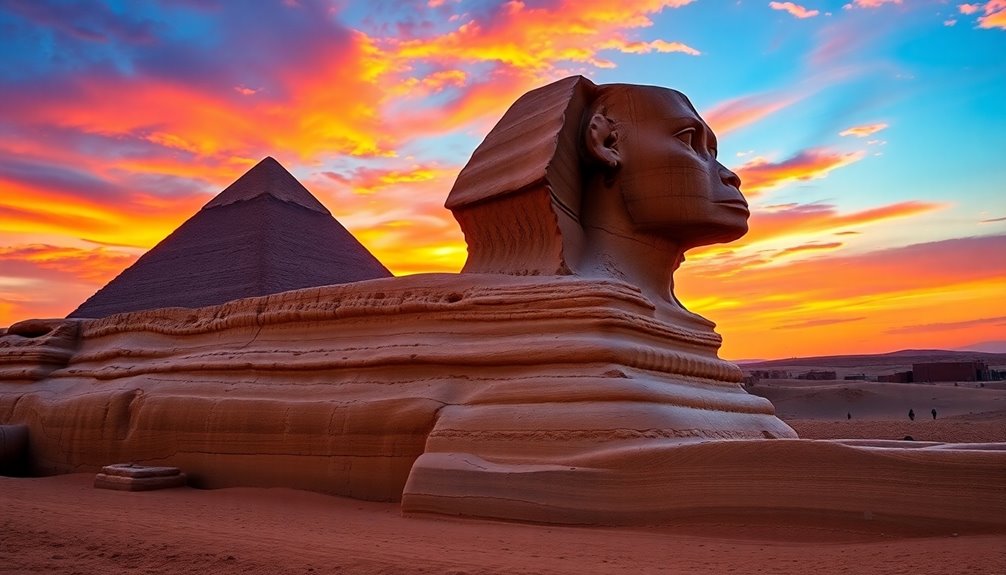
You might wonder about the evidence linking Pharaoh Khafre to the Sphinx.
The stela from Thutmose IV raises intriguing questions about whether Khafre built or merely uncovered this iconic monument.
Additionally, the debate over the Sphinx's facial features adds another layer to understanding Khafre's true connection to it.
Stela Evidence Analysis
Analyzing the stela evidence reveals intriguing complexities about Pharaoh Khafre's connection to the Sphinx. The most significant inscription comes from Thutmose IV's reign, suggesting that Khafre may not have been the original builder of the Sphinx of Egypt. Instead, the stela documents repairs made during Thutmose IV's era, indicating ongoing maintenance rather than a direct connection to Khafre as its creator.
Moreover, the Inventory Stela predates Khafre and implies the Sphinx was already acknowledged and possibly revered long before his reign. This raises essential questions about the true origins of this monumental structure in the ancient world.
Additionally, while some may argue for Khafre's link to the Sphinx, a closer look at the stela evidence analysis shows that Egyptologists have often dismissed findings that contradict this narrative. The potential biases in interpreting Khafre's attribution highlight the need for a more nuanced understanding of the Sphinx's history.
Ultimately, the stela evidence offers a more complicated picture than the traditional view, compelling you to reconsider the Sphinx's ties to Pharaoh Khafre.
Facial Similarity Debate
The complexities surrounding the Sphinx's origins extend to the debate over its facial features and their supposed resemblance to Pharaoh Khafre. While many believe that the Sphinx was built during Khafre's reign, facial analysis suggests otherwise. The features of the Sphinx align more closely with typical characteristics of African populations than with Khafre himself.
| Evidence | Implications |
|---|---|
| Facial Analysis | Suggests Sphinx's features differ from Khafre |
| Inventory Stela | Indicates Sphinx predates Khafre |
| Cultural Archetype | May represent a different individual |
This ongoing debate raises questions about Khafre's connection to the Sphinx, especially considering his pyramid's proximity. While the Dream Stela from Thutmose IV links him to the Sphinx, definitive evidence directly attributing its construction to him remains elusive. As you ponder these clues, it becomes clear that the Sphinx would not only be a monumental statue but also a symbol of Egypt's complex historical narrative. The lions' body of the Sphinx may embody a different legacy, one that invites you to reconsider the narratives surrounding Khafre and the Sphinx's true origins.
Ongoing Debates and Research
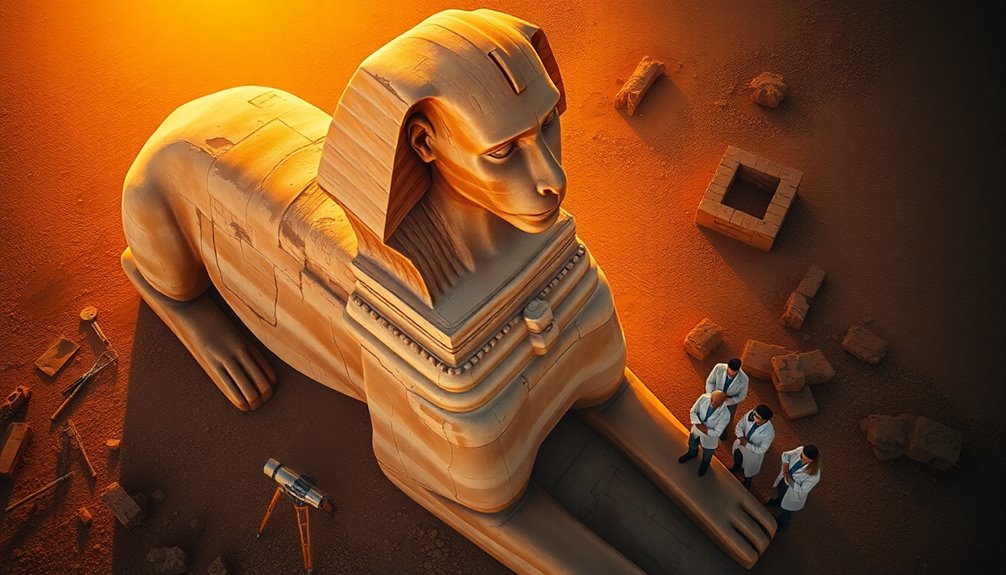
Debates surrounding the age of the Sphinx have captured the attention of both archaeologists and geologists, igniting discussions that blend scientific inquiry with historical speculation.
Ongoing debates center around geological evidence that suggests the Sphinx may have endured significant water erosion, implying it could date back to 10,000-5,000 BCE, a time when the climate was markedly different. This challenges the traditional view that the Great Sphinx was built during Khafre's reign around 2500 B.C.
Researchers like Robert Schoch argue for the possibility that an indigenous civilization constructed the Sphinx, rather than attributing its creation solely to Pharaoh Khafre. This perspective opens the door to exploring the connection between the Sphinx and ancient settlements along the Nile River.
However, credibility issues arise from older theories due to a lack of reliable builder candidates and speculative claims.
As scientific advancements in erosion analysis continue, future studies aim to reconcile these conflicting interpretations. The mystery surrounding the Sphinx's age remains a focal point for ongoing research, with the hope of providing clearer insights into its historical context and construction techniques.
Cultural Significance and Mysteries
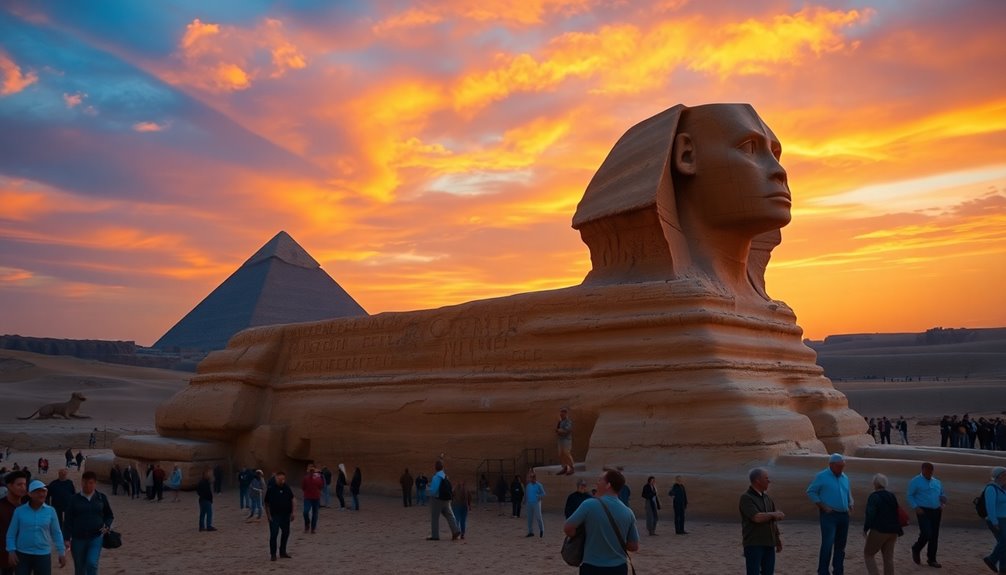
Throughout history, the Sphinx has stood as a powerful symbol of kingship and divine protection, guarding the Giza cemetery for over 4,000 years. You might wonder about the meaning behind its construction. The Sphinx is made of limestone and features a human head, believed to represent Pharaoh Khafre. This connection emphasizes its role as a protector of the pharaohs and their journey to the afterlife.
Some theories suggest that the Sphinx dates back to the last ice age, potentially constructed by a forgotten civilization. This raises intriguing questions about its origins, especially when considering its alignment with the three Great Pyramids and the Orion constellation, which was significant in ancient Egyptian beliefs about death and rebirth.
Renowned archaeologist Flinders Petrie even hinted at the Sphinx's mysterious past. The ongoing debate regarding its builders and age continues to captivate researchers.
While no definitive texts exist to confirm its purpose, the Sphinx remains a symbol steeped in mystery—its monumental presence serving as a proof of human ingenuity and the enduring quest for understanding our ancient past.
Frequently Asked Questions
Is the Sphinx 26000 Years Old?
You might wonder if the Sphinx is really 26,000 years old.
Some researchers argue that its erosion patterns suggest it experienced significant rainfall, hinting at an ancient date. This contrasts sharply with the traditional timeline that places its construction around 2500 B.C.
As new geological evidence emerges, the debate continues, and you're left to contemplate whether the Sphinx truly predates the Old Kingdom and reveals secrets of lost civilizations.
What Does the Bible Say About the Sphinx?
Like a shadow from the past, the Sphinx stands silent, yet it doesn't get a mention in the Bible.
While the text doesn't reference it directly, the Sphinx symbolizes the wisdom and strength of ancient Egypt, which plays a vital role in biblical narratives.
Its connection to themes of divine protection mirrors biblical ideas, highlighting Egypt's cultural significance during the times outlined in scripture, even if the Sphinx itself isn't explicitly noted.
Have They Found Anything Under the Sphinx?
You might be intrigued to know that investigations beneath the Sphinx have revealed some interesting anomalies.
Ground-penetrating radar has indicated potential hidden chambers, and a team led by Dr. Zahi Hawass discovered voids nearby.
Despite these findings, archaeological exploration remains limited.
Robotic cameras are being used to search for more evidence that could illuminate the Sphinx's history and the civilization responsible for its construction.
The mystery continues to captivate researchers and enthusiasts alike.
How Old Do Geologists Think the Sphinx Is?
Geologists, particularly Robert Schoch, suggest the Sphinx might be much older than the commonly accepted date of around 2500 B.C.
They point to unique erosion patterns that indicate significant water exposure, possibly dating it back to 5000 B.C. or even earlier.
This evidence, showing different weathering compared to nearby monuments, strengthens their claim.
Conclusion
As you ponder the age of the Sphinx, remember that mysteries often weave the fabric of history. While some cling to the idea of its 26,000-year existence, others challenge this notion with compelling evidence. The debate continues, inviting you to explore the layers of time and culture. In this dance of discovery, the Sphinx remains a timeless sentinel, urging us to question, learn, and appreciate the ancient wisdom that still resonates today.

